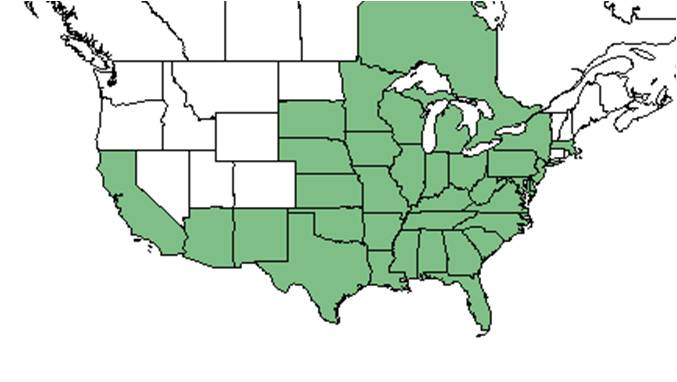Difference between revisions of "Eclipta prostrata"
KatieMccoy (talk | contribs) (→Distribution) |
KatieMccoy (talk | contribs) (→Description) |
||
| Line 23: | Line 23: | ||
<!-- Basic life history facts such as annual/perrenial, monoecious/dioecious, root morphology, seed type, etc. --> | <!-- Basic life history facts such as annual/perrenial, monoecious/dioecious, root morphology, seed type, etc. --> | ||
A description of ''Eclipta prostrata'' is provided in [http://efloras.org/florataxon.aspx?flora_id=1&taxon_id=200023875 The Flora of North America]. | A description of ''Eclipta prostrata'' is provided in [http://efloras.org/florataxon.aspx?flora_id=1&taxon_id=200023875 The Flora of North America]. | ||
| + | |||
| + | ''E. prostrata'' is an annual and can be a short-lived perennial in warmer climates. The reddish-purple stems are covered with short, stiff hairs and can grow prostrate or decumbent and branch occasionally. The leaves are subsessile, elliptic-lanceolate and arranged opposite, with a few blunt teeth along the margin <ref name="EOL">[[http://eol.org/pages/481465/overview Encyclopedia of Life]] Accessed: December 9, 2015</ref>. 1-3 composite flower heads on short pedicels emerge from the axils of the leaves. The ray florets are white, narrow, and short while the disk florets are cream with four small spreading lobes with pale yellow or light brown anthers emerging from them. The bracts form the base of the flowerhead and are green and triangular. | ||
| + | |||
| + | It is a noxious weed in many agricultural crops such as soybean, cotton, rice, sugarcane, peanut, and corn (Chauhan and Johnson 2008). | ||
==Distribution== | ==Distribution== | ||
Revision as of 10:07, 11 December 2015
| Eclipta prostrata | |
|---|---|

| |
| Scientific classification | |
| Kingdom: | Plantae |
| Division: | Magnoliophyta - Flowering plants |
| Class: | Magnoliopsida - Dicotyledons |
| Order: | Asterales |
| Family: | Asteraceae ⁄ Compositae |
| Genus: | Eclipta |
| Species: | E. prostrata |
| Binomial name | |
| Eclipta prostrata (L.) L. | |

| |
| Natural range of Eclipta prostrata from USDA NRCS Plants Database. | |
Common name: false daisy
Contents
Taxonomic notes
Description
A description of Eclipta prostrata is provided in The Flora of North America.
E. prostrata is an annual and can be a short-lived perennial in warmer climates. The reddish-purple stems are covered with short, stiff hairs and can grow prostrate or decumbent and branch occasionally. The leaves are subsessile, elliptic-lanceolate and arranged opposite, with a few blunt teeth along the margin [1]. 1-3 composite flower heads on short pedicels emerge from the axils of the leaves. The ray florets are white, narrow, and short while the disk florets are cream with four small spreading lobes with pale yellow or light brown anthers emerging from them. The bracts form the base of the flowerhead and are green and triangular.
It is a noxious weed in many agricultural crops such as soybean, cotton, rice, sugarcane, peanut, and corn (Chauhan and Johnson 2008).
Distribution
Ecology
Habitat
Eclipta prostata can be found in shallow water in shaded Acer-Nyssa-Taxodium swamps; cypress depression swamps; marsh edges; lake shores; river banks; brackish marshes; seepage areas in calcareous talus; moist sandy-peaty clearings of Baccharis flats; sandy loam of coastal hammocks; pine flatwoods; and river floodplains (FSU Herbarium). It has been found to occur in human impacted areas such as gardens, holding ponds, and drainage ditches. Substrate types include sandy peat, loamy sand and sandy loam soils (FSU Herbarium). Associated species include Typha, Erechtites, Ludwigia, Juncus, Mitreola, Fuirena, and Rhynchospora (FSU Herbarium).
Phenology
Flowers June through November (FSU Herbarium).
Seed dispersal
Seed bank and germination
Fire ecology
Pollination
The following Hymenoptera families and species were observed visiting flowers of Eclipta prostrata at Archbold Biological Station (Deyrup 2015):
Colletidae: Hylaeus confluens
Halictidae: Halictus poeyi, Lasioglossum placidensis, L. puteulanum, L. tamiamensis
Sphecidae: Cerceris tolteca, Ectemnius rufipes ais
Vespidae: Parancistrocerus perennis anacardivora, P. salcularis rufulus, Stenodynerus fundatiformis
Use by animals
Diseases and parasites
Conservation and Management
Cultivation and restoration
Photo Gallery
References and notes
Deyrup, M.A. and N.D. 2015. Database of observations of Hymenoptera visitations to flowers of plants on Archbold Biological Station, Florida, USA.
Florida State University Robert K. Godfrey Herbarium database. URL: http://herbarium.bio.fsu.edu. Last accessed: October 2015. Collectors: Loran C. Anderson, Linnea Angermuller, Sydney T. Bacchus, Kurt E. Blum, D. Burch, Andre F. Clewell, A.H. Curtiss, J.A. Duke, J. Dwyer, R.K. Godfrey, Ann F. Johnson, G.R. Knight, R. Kral, Robert L. Lazor, S.W. Leonard, H. Loftin, J.R. Martinez, Herbert Monoson, C. Nelson, R.A. Norris, Paul L. Redfearn Jr., Grady W. Reinert, Manuel Rimachi Y., Deborah R. Shelley, Sidney Thompson, Edwin L. Tyson, D.B. Ward. States and Counties: Florida: Bay, Brevard, Calhoun, Citrus, Dixie, Flagler, Franklin, Hernando, Jackson, Jefferson, Lake, Lee, Leon, Liberty, Madison, Martin, Sarasota, Seminole, Wakulla, Washington. Georgia: Grady. Country: Columbia, Honduras, Panama, Peru. Compiled by Tall Timbers Research Station and Land Conservancy.
- ↑ [Encyclopedia of Life] Accessed: December 9, 2015